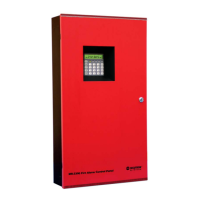43
Indicators, Controls and Operations
9.1 Common Indicators
9.1.1 Buzzer
The Buzzer is activated by any of the following events:
If the Buzzer is turned ON in response to a Non-Latching Trouble or Supervisory, it will be
turned OFF if the condition causing it goes away and there is no other reason for it to be ON.
9.1.2 A.C. ON LED
The green A.C. ON Indicator will illuminate steadily as long as the main AC power is above
minimum level. The indicator turns OFF when the level falls below the power fail threshold and
the panel is switched to standby (battery) power.
9.1.3 Alarm LED
The red Alarm Indicator will illuminate whenever the panel detects an alarm condition on any
initiating circuit. Since all alarms are latched until the panel is reset, the Indicator will remain
ON until then.
9.1.4 Supervisory LED
The amber Supervisory Indicator turns ON steady when there is a Supervisory Alarm in the
Panel caused by any Latching or Non-Latching Supervisory Circuit. The Indicator is turned
OFF when all Non-Latching Supervisory Circuits are restored and there are no active Latching
Supervisory Circuits. Latching Supervisory Alarms remain active until the Panel is reset.
9.1.5 Trouble LED
The amber Trouble Indicator flashes at the Trouble Flash Rate when the panel detects any
trouble condition. It turns OFF when all Non-Latching Troubles are cleared.
9.1.6 CPU Fail LED
The amber CPU FAIL LED flashes approximately ¼ second every 2 seconds to indicate a
processor failure on the main board. In addition, the buzzer sounds in time with the CPU FAIL
LED until the fault is corrected.
Fire Alarm: Steady
Supervisory Alarm: Fast Flash
Trouble: Trouble Flash Rate

